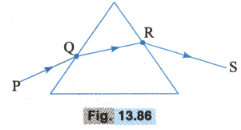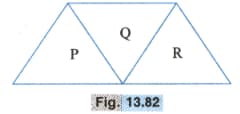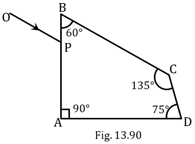Prism
Important Questions on Prism
Light enters a prism of angle A at a grazing incidence to emerge at angle with the normal. Show that the refractive index of the material of the prism is given by
A B and C D are surfaces of two slabs Fig. . The medium between the slabs has refractive index 2. R.I. of the slabs are and respectively. Find the minimum angle of incidence at Q, so that the ray is totally reflected by both slabs.
A ray of light is incident at an angle of on one face of prism which has an angle of The ray emerging out of the prism makes an angle of with the incident ray show that the emergent ray is perpendicular to the face through which it emerges and calculate the refractive
index of the material of the lens.
The refractive of the material of a prism of refracting angle is 1.6 for a certain monochromatic ray. What should be the minimum angle of incidence of this ray on the prism so that no total internal reflection takes place as the ray comes out of the prism?
The refracting angle of a prism is ; If is the angle of minimum deviation and the angle of deviation of a ray which enters at grazing incidence, then show that and where is the r . i of the prism.
The refracting angle of a prism is One of its refracting faces has a coating. A ray of light incident on the other face at an angle falls on the coated surface. On reflection, the ray retraces its path. Find the refractive index of the material of the prism.
Light enters a prism of refracting angle A at grazing incidence to emerge at an angle with normal. Show that the refractive index of the material of prism is :
The refracting angle of a prism is and its refractive index is . If the prism is used at angle of incidence, what will be the deviation of the ray?
A ray of light is refracted through a prism of angle If the angle of refraction in the glass at the first face is what is the angle of incidence in the glass at the second face ?
A ray of light passes through an equilateral prism such that the angle of incidence is equal to the angle of emergence and the latter is equal to of the angle of the prism. Determine the angle of deviation and the refractive index of the material of the prism.
Angle of minimum deviation for a prism of refractive index is equal to the angle of the prism. Find the angle of the prism.
The refracting angle of a prism is and the angle of minimum deviation of a ray through the prism is What is the refractive index of the material of the prism ?
Show the nature of the curve for a prism. Analyse the curve to show that for any particular value of , the difference between the fixed values of and decrease with the decrease of and becomes zero for minimum.
Draw a diagram showing a ray of light incident on a thick prism, refracted through it and emergent out of it. Show that and.[Symbols have their usual meaning]. Show in the above diagram that for angle of incidence or deviation remains the same.
What is a prism? Cite some specific uses of prisms. A ray of light is incident normally on a refracting face of a prism whose refracting angle is Draw the path of the ray through the prism. Suppose, the critical angle for glass is and that the prism has two faces.
A ray of monochromatic light is incident on the face of prism near vertex at an incident angle of , Fig. . If the refractive index of the material of the prism is , which of the following is (are) correct?
Two beams of red and violet colours are made to pass separately through a prism (angle of the prism is ). In the position of minimum deviation, the angle of refraction will be
A ray of light is incident on an equilateral glass prism placed on a horizontal table Fig . For minimum deviation which of the following is true?

A given ray of light suffers minimum deviation in an equilateral prism Fig. . Additional prisms and of identical shape and of the same material as and now added as shown in the figure. The ray will suffer

A ray is incident on an equilateral prism of r.i. . The ray emerges from the prism with a deviation of The angle made by the ray inside the prism with the base of the prism is


